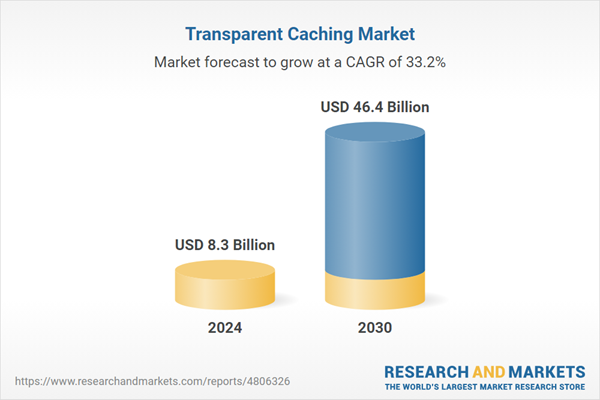The global market for Transparent Caching was valued at US$8.3 Billion in 2024 and is projected to reach US$46.4 Billion by 2030, growing at a CAGR of 33.2% from 2024 to 2030. This comprehensive report provides an in-depth analysis of market trends, drivers, and forecasts, helping you make informed business decisions. The report includes the most recent global tariff developments and how they impact the Transparent Caching market.
Segments: End-Use (Internet Service Providers, Telecom Operators, Direct-to-Home (DTH) Cable service Providers, Enterprises, Governments, Other End-Uses).
Geographic Regions/Countries: World; United States; Canada; Japan; China; Europe (France; Germany; Italy; United Kingdom; and Rest of Europe); Asia-Pacific; Rest of World.
The analysts continuously track trade developments worldwide, drawing insights from leading global economists and over 200 industry and policy institutions, including think tanks, trade organizations, and national economic advisory bodies. This intelligence is integrated into forecasting models to provide timely, data-driven analysis of emerging risks and opportunities.
Global Transparent Caching Market - Key Trends & Drivers Summarized
What Is Transparent Caching and Why Is It Important?
Transparent caching is a network optimization technique that involves storing copies of frequently accessed content close to end-users to reduce latency and improve load times. Unlike traditional caching methods, transparent caching operates at the network level without requiring changes to end-user devices or content delivery networks. This technique is particularly beneficial for Internet Service Providers (ISPs) and Content Delivery Networks (CDNs) as it helps reduce bandwidth consumption, enhance user experience, and manage network traffic more efficiently. Transparent caching is crucial for handling the increasing volume of online content and the growing demand for high-speed, reliable internet services.How Have Technological Innovations Shaped the Market?
Technological advancements have significantly influenced the transparent caching market. The development of advanced caching algorithms and machine learning techniques has improved the efficiency and accuracy of content delivery. Modern transparent caching solutions can dynamically adapt to changing network conditions and user behavior, ensuring optimal performance. The integration of transparent caching with other network optimization technologies, such as content delivery networks (CDNs) and edge computing, has further enhanced its capabilities. Additionally, advancements in storage technologies, including the use of high-performance solid-state drives (SSDs), have improved the speed and reliability of transparent caching systems. These technological innovations have expanded the applications of transparent caching and enhanced its value in network optimization.Who Are the Key Users and What Are Their Needs?
The key users of transparent caching solutions include Internet Service Providers (ISPs), Content Delivery Networks (CDNs), and large enterprises. ISPs use transparent caching to manage network traffic, reduce bandwidth costs, and enhance the quality of service for their customers. CDNs leverage transparent caching to optimize content delivery, reduce latency, and improve user experience. Large enterprises, particularly those with high traffic websites and applications, utilize transparent caching to ensure fast and reliable access to their content. Each of these user groups demands caching solutions that offer high performance, scalability, and ease of integration with existing network infrastructure.What Is Driving Growth in the Transparent Caching Market?
The growth in the transparent caching market is driven by several factors, including the increasing volume of online content, the growing demand for high-speed internet services, and advancements in network optimization technologies. The exponential growth of online content, particularly video streaming and rich media, has necessitated the use of transparent caching to manage bandwidth and improve content delivery. The rising demand for high-speed internet services, driven by the proliferation of connected devices and the expansion of broadband networks, has further fueled the adoption of transparent caching solutions. Advancements in network optimization technologies, including the integration of caching with CDNs and edge computing, have enhanced the performance and capabilities of transparent caching systems. Additionally, the increasing focus on improving user experience and reducing operational costs has spurred the adoption of transparent caching in various sectors.Report Scope
The report analyzes the Transparent Caching market, presented in terms of units. The analysis covers the key segments and geographic regions outlined below.Segments: End-Use (Internet Service Providers, Telecom Operators, Direct-to-Home (DTH) Cable service Providers, Enterprises, Governments, Other End-Uses).
Geographic Regions/Countries: World; United States; Canada; Japan; China; Europe (France; Germany; Italy; United Kingdom; and Rest of Europe); Asia-Pacific; Rest of World.
Key Insights:
- Market Growth: Understand the significant growth trajectory of the Internet Service Providers segment, which is expected to reach US$17.8 Billion by 2030 with a CAGR of a 34.5%. The Telecom operators segment is also set to grow at 37.1% CAGR over the analysis period.
- Regional Analysis: Gain insights into the U.S. market, valued at $2.4 Billion in 2024, and China, forecasted to grow at an impressive 31.2% CAGR to reach $6.7 Billion by 2030. Discover growth trends in other key regions, including Japan, Canada, Germany, and the Asia-Pacific.
Why You Should Buy This Report:
- Detailed Market Analysis: Access a thorough analysis of the Global Transparent Caching Market, covering all major geographic regions and market segments.
- Competitive Insights: Get an overview of the competitive landscape, including the market presence of major players across different geographies.
- Future Trends and Drivers: Understand the key trends and drivers shaping the future of the Global Transparent Caching Market.
- Actionable Insights: Benefit from actionable insights that can help you identify new revenue opportunities and make strategic business decisions.
Key Questions Answered:
- How is the Global Transparent Caching Market expected to evolve by 2030?
- What are the main drivers and restraints affecting the market?
- Which market segments will grow the most over the forecast period?
- How will market shares for different regions and segments change by 2030?
- Who are the leading players in the market, and what are their prospects?
Report Features:
- Comprehensive Market Data: Independent analysis of annual sales and market forecasts in US$ Million from 2024 to 2030.
- In-Depth Regional Analysis: Detailed insights into key markets, including the U.S., China, Japan, Canada, Europe, Asia-Pacific, Latin America, Middle East, and Africa.
- Company Profiles: Coverage of players such as Adaptigent, Akamai Technologies, Inc., ARA Networks Co., Ltd., Broadcom, Inc., Citrix Systems, Inc. and more.
- Complimentary Updates: Receive free report updates for one year to keep you informed of the latest market developments.
Some of the 43 companies featured in this Transparent Caching market report include:
- Adaptigent
- Akamai Technologies, Inc.
- ARA Networks Co., Ltd.
- Broadcom, Inc.
- Citrix Systems, Inc.
- Fortinet, Inc.
- Huawei Technologies Co., Ltd.
- Kollective Technology, Inc.
- Nexnet Solutions
- Qwilt
Tariff Impact Analysis: Key Insights for 2025
Global tariff negotiations across 180+ countries are reshaping supply chains, costs, and competitiveness. This report reflects the latest developments as of April 2025 and incorporates forward-looking insights into the market outlook.The analysts continuously track trade developments worldwide, drawing insights from leading global economists and over 200 industry and policy institutions, including think tanks, trade organizations, and national economic advisory bodies. This intelligence is integrated into forecasting models to provide timely, data-driven analysis of emerging risks and opportunities.
What’s Included in This Edition:
- Tariff-adjusted market forecasts by region and segment
- Analysis of cost and supply chain implications by sourcing and trade exposure
- Strategic insights into geographic shifts
Buyers receive a free July 2025 update with:
- Finalized tariff impacts and new trade agreement effects
- Updated projections reflecting global sourcing and cost shifts
- Expanded country-specific coverage across the industry
Table of Contents
I. METHODOLOGYII. EXECUTIVE SUMMARY2. FOCUS ON SELECT PLAYERSIII. MARKET ANALYSISIV. COMPETITION
1. MARKET OVERVIEW
3. MARKET TRENDS & DRIVERS
4. GLOBAL MARKET PERSPECTIVE
UNITED STATES
CANADA
JAPAN
CHINA
EUROPE
FRANCE
GERMANY
ITALY
UNITED KINGDOM
REST OF EUROPE
ASIA-PACIFIC
REST OF WORLD
Companies Mentioned (Partial List)
A selection of companies mentioned in this report includes, but is not limited to:
- Adaptigent
- Akamai Technologies, Inc.
- ARA Networks Co., Ltd.
- Broadcom, Inc.
- Citrix Systems, Inc.
- Fortinet, Inc.
- Huawei Technologies Co., Ltd.
- Kollective Technology, Inc.
- Nexnet Solutions
- Qwilt
Table Information
| Report Attribute | Details |
|---|---|
| No. of Pages | 193 |
| Published | April 2025 |
| Forecast Period | 2024 - 2030 |
| Estimated Market Value ( USD | $ 8.3 Billion |
| Forecasted Market Value ( USD | $ 46.4 Billion |
| Compound Annual Growth Rate | 33.2% |
| Regions Covered | Global |









